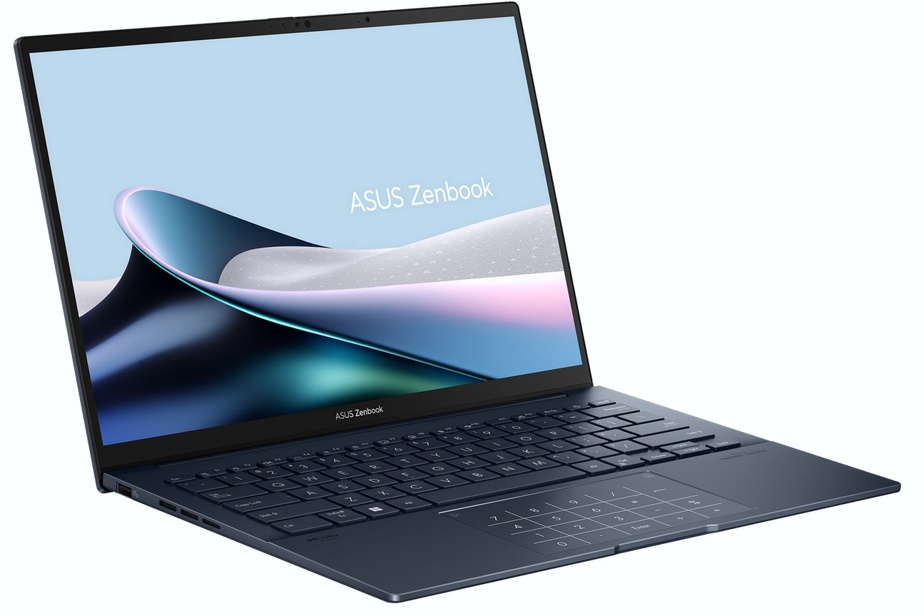The latest from Asus, the Zenbook 14 OLED, is a speed monster packed into a beautiful design and a superb 14-inch OLED touchscreen. All he needs is a good ability to manage video games to be perfect.
The Zenbook 14 OLED laptop from manufacturer Asus is our first test of the new Intel Core 7 Ultra 155H processor, clocked in turbo mode at 4.8 GHz with 16 GB of RAM, for the model we received. It is seen by many observers as Intel’s response to Apple Silicon processors which deliver stratospheric performance.
It’s almost mission accomplished, if we rely on our calibration with Geekbench 6. With a score of 12,512 for all the work provided by its 16 cores, the Zenbook 14 OLED flirts with Apple’s M2 chip. The newer M3 chip, however, still remains out of reach, for example reaching a score of 21,057 for the MacBook Pro launched in November 2023. Our Zenbook outperforms the score of Microsoft’s Surface Pro 9 (8830) and reaches that of an exemplary PC laptop, the Galaxy Book3 Ultra, with 12,436.
So, very fast and powerful, this Zenbook 14 OLED, and its 1 TB SSD hard drive which gives us an incredible reading speed of 3492 Mb/s for large files, does not spoil the good impression. The software opens in the blink of an eye, navigation is fluid, access to the hard drive is without delay. In two weeks of testing, our laptop showed no sign of weakness in daily activities, including image or sound processing.
We have in our hands a very nice, rather light laptop, weighing 1285 grams according to our kitchen scale. The touch is pleasant, with a well-felt rebound of 1.4 mm, backlighting and even accents for the French-speaking user. Its touchpad offers a surprise: it transforms into a numeric keypad, numbers and lighted controls appear there . We have well equipped it on the output side with two Thunderbolt 4 type C sockets, capable of providing 65 watts and connecting our computer to an external monitor. If that’s not enough, there’s also an HDMI 2.1 output, a USB 3.2 Type A jack and a 3.5mm audio jack.
We’re beating around the bush a little, we haven’t talked about its 14-inch touch screen which is probably the distinctive touch of this computer. As its name suggests, we are entitled to OLED (DELO in French), which allows perfect blacks and very thin screens, barely 5 mm here. It is simply magnificent, to the point where adding an external monitor becomes a luxury. With 3K resolution of 2880 x 1800 and peak brightness of 550 nits, 100% DCI-P3 color gamut reproduction capability with a refresh rate of up to 120 Hz, for a rare time on a PC we have a serious competitor to Apple’s beautiful Retina. Each manufacturer has its own jargon, Asus, here, has named it “Lumina”. The bezels are tiny, with the screen taking up 87% of the front space.
The built-in speakers for such a thin computer are obviously not mind-blowing quality but do a decent job. The front camera provides a resolution of 1080p which is also respectable here, with a very precise image but with colors that seem washed out as soon as the light is low.
For authentication, an infrared camera has been included which allows the use of Windows Hello. The announced autonomy is around fifteen hours in well-controlled circumstances. We instead got between 9 and 16 hours depending on usage, which is good.
The Geekbench 6 benchmark doesn’t tell the whole story. The graphics processing capacity of the Zenbook 14 OLED reaches that of mid-range computers designed for video games, with a score of 32,922. In fact, we were not able to run any AAA games on this computer. Only smaller games could be handled acceptably.
We had some small configuration issues, perhaps caused by the fact that this computer had not been reset. Connecting to an external monitor, in particular, was laborious.
Asus makes it clear from the outset that this is a “computer for the home”. For this use, it is impeccable and delivers flawless performance at an overall acceptable price. For editing and video games, on the other hand, its limitations are quickly evident and it will not satisfy the more demanding buyer.
